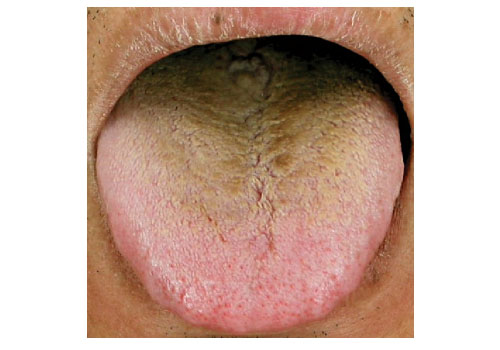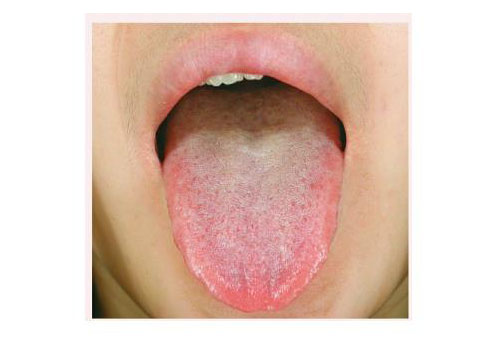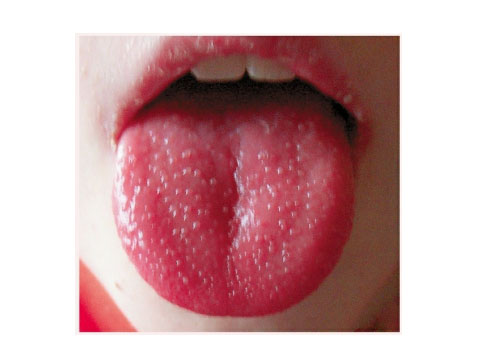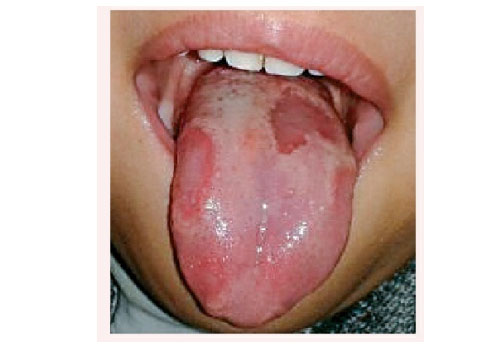The normal tongue coating is thin and white,light red and the tongue is exposed on edge. When Tongue diagnosis, we should look at the tongue coating and the tongue body.
The structure of tongue is very interesting and complex. On one tongue, the tongue coating is spread in the middle of the tongue body, which is usually a thin white coating;
The one on the side is called the tongue proper, a translucent mucous membrane; there are several large protrusions on the last tongue base, called contour papillae. ——Because it is protruding, it is named nipple in medicine, it is the outline of the tongue, and the whole tongue body is in front.
Many people may not have observed this, so when some people learn tongue diagnosis, they see something on the base of the tongue: “Oh my God, something is growing on my tongue, what should I do?”
This is Everyone has things, but some people can see with their tongues stretched out long enough and their mouths wide enough; You can see a lot of small red dots, which are rich in capillaries, so it is red.
Everyone has little red dots on their tongues, we call them mushroom papillae, which are actually related to taste.
What is the tongue coating like?
The normal tongue coating is white and thin. If you observe it under a microscope, you will find traces of it, which we call filiform papillae. However, the tongue coating is not only made up of filamentous papillae, it is not that simple.
We know that the tongue is closely related to nature. It contains food residues, some microorganisms, and necrotic cells (cells shed from the tongue), so the tongue is a microenvironment.
Is scraping tongue coating good for health?
Some people will think that the tongue is very dirty, how good is it to clean it? But this is not possible. If you do clean it up, It will destroy the probiotics and the food will have problems digesting it.
As we all know, more than 400 kinds of bacteria live with us in the intestinal tract. It is impossible to kill them, because they are involved in the decomposition and digestion of food. Why do many children suffer from spleen deficiency after taking too many antibiotics, either spleen yang deficiency or spleen yin deficiency?
Modern medicine says that there is a problem in the intestines or there is a problem with digestion. But from the point of view of traditional Chinese medicine, the child’s spleen is deficient, and the complexion is pale and bloodless, indicating that the body cannot absorb nutrients.
What is the reason?
Antibiotics are used too much, and the bacteria in the intestines have been eliminated. Although the intestines have become so-called clean, the digestive function has also declined. And after the probiotics are eliminated, the fungus begins to grow.
Fungi are difficult to kill by antibiotics. It causes damage to the intestinal wall, and the toxins they secrete will escape into the blood, circulate with the blood to the brain, stimulate the brain nerves, and induce autism. Therefore, the latest paper published says that autism is related to the excessive use of antibiotics.
Our body is a large environment, and each part, structure, and microenvironment has its own function, restricts and promotes each other, and cannot be changed or removed at will.
For example, the appendix. We used to think that the appendix could be removed. In fact, some studies now say that the appendix is actually a “Noah’s Ark”, which stores almost all the bacteria in the intestinal tract.
When the bacteria in the intestinal tract are killed, the appendix The bacteria in it begin to multiply and stabilize your gut, so the appendix actually acts as a stabiliser to the gut, and if it is cut, it will diminish the gut’s ability to recover. The same is true for the body of the tongue.
Some people say that it looks good when I clean my tongue. In fact, it is totally unnecessary, because it participates in the stirring and digestion process of food, especially its microenvironment, which may be very important to the body, and may even be the first stage of human digestion of food.
The tongue coating color and healthy
Thick tongue coating indicates heavy moisture in the body; thin tongue coating indicates stomach problems. When our righteousness is insufficient and the spleen and stomach are weak, the microenvironment on the tongue body will change, the shape of the tongue coating will change, and the tongue coating will never change.
From thin to white, to thick, this process is a process that shows whether the body’s righteousness is sufficient. If the tongue coating is too thin, there are two possibilities. If the tongue is white and the coating is too thin, it means that the stomach qi is weak;
But in any case, the tongue coating is gone, indicating a problem with the righteousness. However, if the tongue coating becomes thick, there are too many external pathogens. For example, if the tongue coating is thick and greasy, the body is too damp.
If the dampness reaches a certain level, it will condense into phlegm. This is phlegm-dampness, which will hinder the circulation of qi and blood, and cause many problems in the body.
Therefore, the thickness of the tongue coating is a dynamic process. So what about tongue coating?
Good or bad? It is not good if it is too much or too small. It reflects the good and evil qi in our body: more tongue coating means that the body is full of evil qi, and less tongue coating means that the body’s righteous qi is insufficient.
How to observe the tongue coating color to judge health
For the tongue coating, the most basic color is light white. When the body has a problem, which direction will its color change?
1) The color of the tongue coating will deepen when you get an exogenous infection.
First of all, when an exogenous evil strikes, the color of the tongue coating will deepen as the exogenous evil enters the inside and turns heat.
What will it be like?

It will become pale yellow, yellow, gray, and burnt black.
What does this mean?
The heat increases when the external sensation is felt, and when the tongue coating is charred, the heat is already very heavy.
In ancient times, even in the past rural areas, there were no such good medical conditions. When someone gets sick, they get a high fever until the tongue coating is black.
2) When the body is heavily damp, the tongue coating will change from thin coating to sticky, turning yellow…
The tongue coating will also change when the dampness is heavy, whether it is exogenous dampness or endogenous dampness. If the dampness is heavy, the tongue coating will change from thin to sticky and then turn yellow, which indicates that the body has begun to have dampness heat and is developing towards the direction of heat.
If the tongue coating turns gray and black, it means that the body is very humid at this time. When it finally turns black, it is covered with saliva, but it is not brown or black, but a very moist black, indicating that the more moisture getting heavier. This is not usually the case, but we also need to know.
In short, the tongue coating will change more than the tongue body. The tongue coating is particularly sensitive to changes, and the tongue body is relatively stable.
Why? Because the righteousness of the body generally does not disappear suddenly, or the body heats up suddenly, the righteousness changes little by little. However, some patients often experience the sudden disappearance of the tongue coating overnight—the tongue coating suddenly disappears, which indicates that the patient’s physical condition has deteriorated sharply.
Sometimes the tongue coating will suddenly become full of mouth. For example, it was a sunny day a few days ago, but now it is suddenly foggy, the dampness is aggravated, and the yang qi in the body is insufficient, and the spleen and stomach are weak. This may happen this.
3) Whether the blood circulation of the body is good or not
During tongue diagnosis, we also need to observe the blood filling on the tongue. When the blood is sufficient, the tongue color is light red. If the blood flow changes, for example, the blood flow is very slow, and the blood supply cannot come up, it will appear light white color. The most obvious is that when the blood is blocked, the tongue will change significantly – no matter where there is blood stasis in the body, there will be a reaction on the tongue, such as the two veins under the tongue will change.




